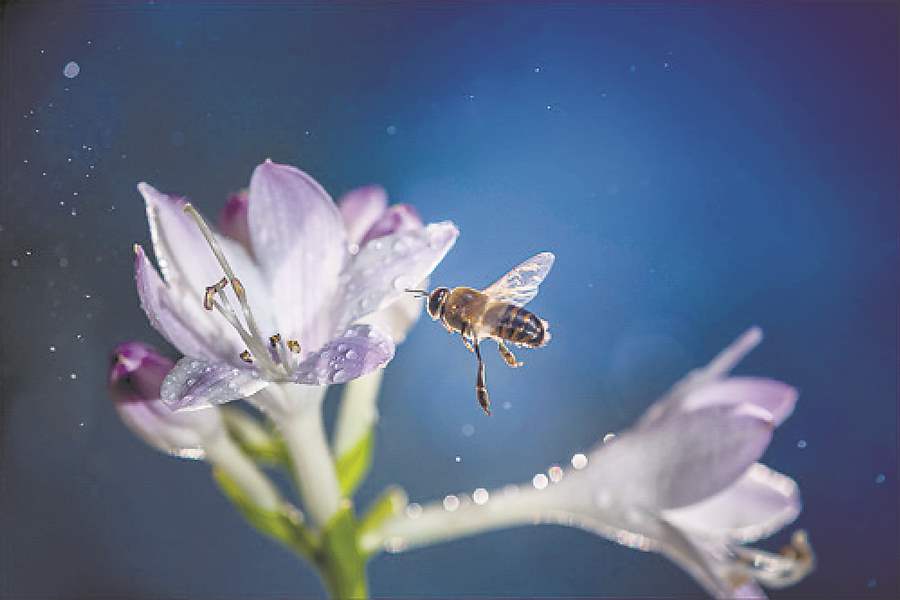
NATURES
‘Wild Light’ is center’s latest effort to connect people with their surroundings
7/16/2017
Rick Lieder
(Editor’s Note: This story has been corrected to show the National Center for Nature Photography is in Secor Metropark, not Oak Openings Preserve.)
Twenty miles southwest of Toledo, the Oak Openings begin, and the land grows strange.
Grass gives way to dunes, low-lying wetlands, and black oak forests. Hundreds of years ago, before this region was settled, fires roiled across the landscape in a dependable rhythm, just as much a part of life there as the deep-rooted savanna grasses and the long-tailed lark sparrows which made their homes in the grasses and dunes.
In the expanses cleared by those fires, wild Lupine bloomed a delicate violet, the only home for the larvae of the Karner blue butterflies, which were first identified by the novelist Vladimir Nabokov and whose natural range stretched across the Midwest.
Those butterflies — Nabokov wrote that their iridescent wings shone a “celestial blue”— still touch down on Lupine today, though their numbers are diminished. The fires still rage, but they are managed now by human keepers tasked with preserving a fragile ecosystem.
Nestled in the Secor Metropark in the Oak Openings region, the National Center for Nature Photography stewards the landscape in other ways.
“The Oak Openings — its beauty is kind of subtle,” said Scott Carpenter, a spokesman for Metroparks of the Toledo Area. “It’s not a canyon, or a mountain, or an ocean.”
The center works to showcase the understated beauty of the rare, delicate region. The philosophy, Carpenter said, is that “people will protect what they love.”
The center was founded in 2003 when an existing nature center at the site needed renovation.
“We wanted to do something special with it, something we didn’t have here,” Carpenter said.
Art Weber, formerly the spokesman for Metroparks, was also a nature photographer and agreed to direct the center in its beginning stages.
In addition to housing a regular exhibit featuring photographs of the Oak Openings, the center also showcases work from a wide array of locally and nationally known photographers. In 2008, the center hosted Touch the Sky, a show by Jim Brandenburg, an award-winning photographer for National Geographic, which captured Midwestern prairie vistas.
“That’s the idea — to celebrate the great natural areas in one of the great natural areas,” Carpenter said.
Often, these photographers will give lectures and host workshops at the center in addition to their exhibits, and the center has regular classes, workshops, and photo contests throughout the year.
Steve Gettle, a nature photographer based in Michigan, has had two solo exhibitions at the center — one around the time of its opening and another in 2015. The second, called “Avian Images,” coincided with the Biggest Week in American Birding, a festival held by the Black Swamp Bird Observatory. Both of the exhibits were accompanied by workshops and seminars.
“One of the most powerful things about nature photography is its ability for storytelling. It can cross all language barriers, all age barriers, and it’s a great way to educate the public about what we have in the natural world, and that’s why I do it,” Gettle said.
The center is hosting Wild Light, an exhibit of 80 photographs,16 illustrations, and footage shot by Berkley, Mich.,-based Rick Lieder, whose work has been featured in, among other places, a National Geographic-produced documentary. He considers himself an artist more than a photographer or painter or illustrator in particular.
“To me, the fun of what I’m doing — working in many different areas — is that I can find the right tool to express whatever idea I’m having,” he said. “Whether that’s painting in oils, or watercolor, or a computer, or a camera.”
What ties together his art, he said, is a focus on “emotion and lighting.”
The exhibit, which is on display through Aug. 25, bears his ethos out.
In one photo, an ant is photographed in dramatic, ultra-close focus, clinging to pine needles captured on a monumental scale. In another, a bluejay in flight occupies the center of the frame, each of its deep blue, black-fringed feathers fanned out and captured in sharp detail. And a great many of the pictures — about one in 10 — capture fireflies. They shine yellow against the backdrop of a soft blue night or a dusk illuminated by the sun, glowing orange and made small by the closeness of the camera’s zoom.
Lieder has been photographing many fireflies recently, even collaborating with the poet Helen Frost to devote a whole picture book to them. He sees capturing the beauty of a relatively commonplace insect like the firefly as part of photography’s educational potential.
“A lot of my work is encouraging people to look around them,” he said. “Most of what I do in my exhibit is in my backyard, which is probably not that different from anybody else’s backyard. It’s not the place that you’d think of to do really great wildlife photography.”
“Wild Light” is on view at the National Center for Nature Photography Fridays, Saturdays and Sundays, from 10 a.m. to 4 p.m. Mr. Lieder’s work is featured in a series of picture books — “Step Gently Out,” “Sweep Up the Sun,” “Among a Thousand Fireflies,” and the just-released “Wake Up!” — with his co-author Helen Frost. Signed copies of the books will be available during BugFest on Aug. 19 at Secor Metropark.
Contact Victorio Cabrera at vcabrera@theblade.com, 419-724-6050 or on Twitter @vomcabrera.